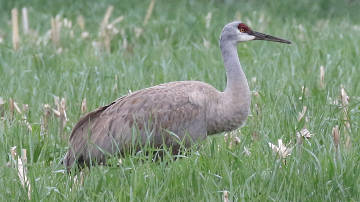

PHOTO COURTESY OF GARRY KESSLER
A sandhill crane in a field in Westborough
May 19, 2017, Page B4
NATURE NOTES
By Annie Reid
Westborough Community Land Trust
Something different – a sandhill crane
The migration season is here, bringing us the usual birds that come here to breed as well as birds that pass through on their way farther north, but every once in a while, a very different bird appears. One such rare visitor in early May was a big one – a sandhill crane spotted in the Mass Wildlife agricultural fields just north of Lake Chauncy near the former Westborough state hospital land.
Talk about “big birds”: sandhill cranes (Antigone canadensis) are about 4 feet long with a 6-foot wing span and weigh about 10 pounds. They are surprisingly graceful, without the prehistoric look that our great blue herons (Ardea herodias) have in flight. Our familiar great blue herons are about as tall but weigh only half as much, with a more slender profile, and we can see them in our area much of the year.
Sandhill cranes are gray with a red crown. They’re wading birds that feed in fields and meadows as well as wetlands. Most winter in Florida and the southwest – Texas, New Mexico, Arizona, and Mexico – but migrate north to breed in wetlands in the Great Lakes region and Canada.
So what’s a sandhill crane doing here? Migrating sandhill cranes in the eastern U.S. typically fly an inland route, bypassing New England and much of the east coast altogether. They can fly 500 miles in a 9- or 10-hour day. Our recent visitor may have gotten off course and found our local field suitable for a stopover for resting and feeding.
Another possibility is that this sandhill crane might be one of the few that breed in New England (although it seems to have moved on from Westborough). Every year a few sandhill cranes are seen in Massachusetts. In the past 10 years, at least one pair has been documented as breeding in western Mass (see “Sandhills in Massachusetts” in Massachusetts Wildlife magazine, No. 2, 2007).
Sandhill cranes, which are native to North America, are the most abundant cranes in the world. With a few exceptions (in Florida, Mississippi, Cuba), most of their populations have been increasing in recent decades. The population that breeds in the Great Lakes region has been gradually expanding its breeding area eastward.
Sandhill cranes are noted for their elaborate and graceful courtship dance and for their bugle-like calls. Who knows? The future may hold these sights and sounds for Massachusetts if we continue to conserve our wetlands and agricultural fields.